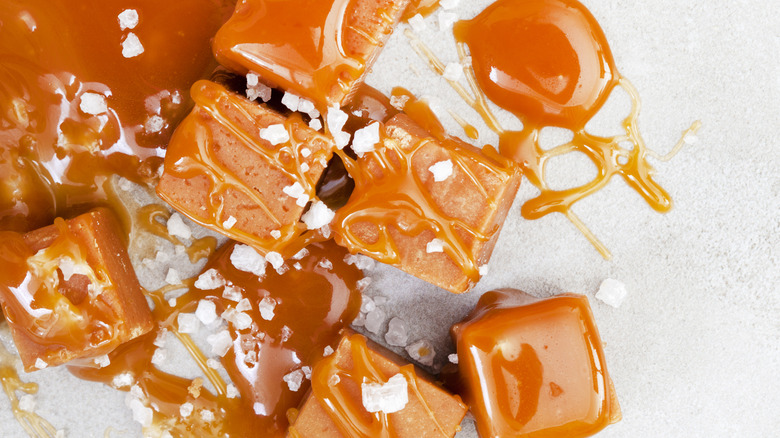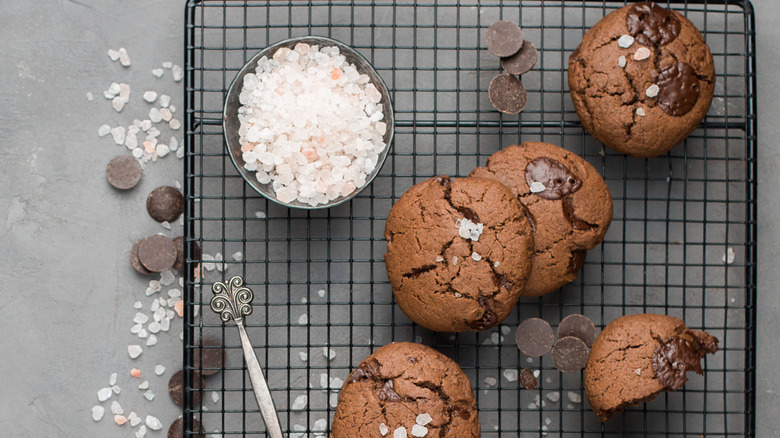Why Food Tastes Sweeter With A Dash Of Salt
From salted caramel to salty, pickled Chamoy sauce atop intensely sweet mango, it seems as though salt and sugar can't get enough of each other. But why is it that salt pairs so well with sweet foods? And why does a dash of salt seem to enhance rather than diminish sweetness?
The answer starts with the tongue. The human tongue can perceive five tastes: sweetness, saltiness, bitterness, sourness, and umami. While specific areas of the tongue do sense certain flavors with more sensitivity — the back of the tongue picks up on bitterness, for example — the cells in the tongues can respond to several different flavors at once, with varying degrees of intensity. As such, combining tastes can impact how we perceive a food's overall flavor, and salt can both suppress and enhance in equal measure.
Saltiness is a simple, straightforward taste, but it can change depending on the amount of salt we consume. Large concentrations of salt, for example, can be perceived as bitter or even sour, while lower concentrations of salt actually enhance a food's sweetness. This variation in the perception of salt's taste might be because of multiple salt detection "pathways" within our taste buds, which help detect an overconsumption of salt that might have negative health effects. The exact mechanism for these "pathways," however, has not yet been explained.
Tasting beyond the tongue
One example of how salt alters other flavors is how it inhibits the ability to taste bitterness, making a bitter grapefruit taste sweeter. This is because salt diminishes our ability to perceive the taste of compounds called naringin, which give grapefruits their signature, bitter taste. Salt also helps concentrate flavors and makes the smell of certain foods more noticeable thanks to how it interacts with water molecules. This is a particularly attractive attribute when salt is added to grapefruits, which have a high water content; salt can help launch bound molecules responsible for scent into the air. And scent, of course, is a key factor in our taste perception.
Chloride, an essential part of salt's makeup, can also bind with sweet taste receptors, making sweet tastes more perceptible. Of course, even this explanation isn't fully understood. What we do know, however, is that salt has always been a well-known natural flavor enhancer and can, in proper balance, help round out pretty much any recipe, dulling bitterness, highlighting sweetness, and making the most out of pretty much any food. Salt is, after all, necessary in almost every dish, whether by the teaspoon or simply sprinkled on top. In fact, it might just be the missing ingredient in your dessert endeavors.
When salty meets sweet
Though the reasons behind salt's sweetness-enhancing abilities are quite complex, the simple fact is that salt can perfect any number of foods, from fruit to confection — and the possibilities extend past grapefruit and caramel. Salted watermelon, for example, is a classic summer staple in the American South. And salty, pickled Chamoy sauce makes a great addition to almost any fruit.
Beyond produce, however, salt can be added to any number of confections to both enhance sweetness and add a touch of complexity. Adding a sprinkle of salt to chocolate ice cream, for example, can bring a new level of enjoyment to the childhood staple by contrasting the ice cream's sweet taste and helping to highlight the chocolate's complex flavor profile. Beyond ice cream, adding a sprinkle of fleur de sel to a pan of blondies can also amp up a relatively simple dessert, rounding out the brown sugar taste and layering what might otherwise be a one-note dessert.


